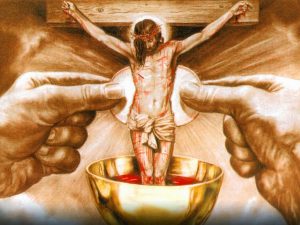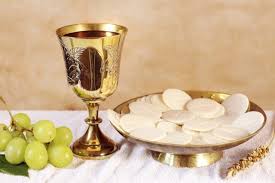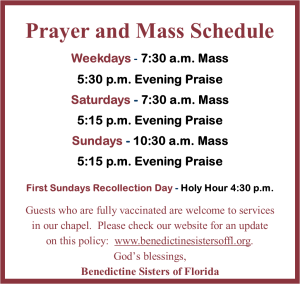 This is one of my favorite feasts. It celebrates the ultimate in self-giving, not only to lay down one’s life for another but, further, to freely give one’s essence to another. This story of the feeding of the 5,000 is the only one of Jesus’ miracles that appears in all four Gospels. In Luke’s version the feeding of the crowd is not the result of Jesus’ compassion for the crowd. It is an incentive to the disciples to do something about the problem they perceive. When they want Jesus to send the crowd away so they (the crowd and themselves) can get something to eat, Jesus tells them, “Give the people some food on your own.” When we come to the Eucharistic table, hungry for the Word of God and the Body of Christ, what does the Jesus, in the person of the priest say? “Take this, all of you, and eat of this. Take this, all of you, and drink.”
This is one of my favorite feasts. It celebrates the ultimate in self-giving, not only to lay down one’s life for another but, further, to freely give one’s essence to another. This story of the feeding of the 5,000 is the only one of Jesus’ miracles that appears in all four Gospels. In Luke’s version the feeding of the crowd is not the result of Jesus’ compassion for the crowd. It is an incentive to the disciples to do something about the problem they perceive. When they want Jesus to send the crowd away so they (the crowd and themselves) can get something to eat, Jesus tells them, “Give the people some food on your own.” When we come to the Eucharistic table, hungry for the Word of God and the Body of Christ, what does the Jesus, in the person of the priest say? “Take this, all of you, and eat of this. Take this, all of you, and drink.”
That’s the challenge before us. What, exactly, does Jesus mean by “food.”? The story is about food for the body in a deserted place. People who live in fear and hiding lest they be persecuted or killed over the practice of their religion certainly live in a deserted place. The “food” they desire is the courage, the support to sustain them in faith. We pray that all people of goodwill will find strength in hope, convinced that, as St. Paul wrote to the Romans, “the sufferings of the present time are not worthy to be compared with the glory to come.” (Romans 8:18) In the midst of current challenges may they, and we, seek the kingdom and find strength in hope.
I recall in 1959-60 when our wood-frame convent was condemned by the fire department. The townspeople responded with open hearts when they were asked: “May we live with you until we can build a new house?” We certainly felt “welcomed as Christ” – the people viewed it a privilege to house the sisters and some of our boarding school students.
PS I will share another true little story with a Eucharist theme.
One day (in a Montessori class of 4-5 year-olds) I had shown a filmstrip. (Remember them? They were the precursors of PowerPoint and Smart Boards.) After the class had viewed the story of the Miracle of the Loaves and Fishes, I asked them to tell me the story. Martha was so animated that the rest of the class sat mesmerized as she explained how it happened. “There was a little boy named Benjamin who had some bread. He gave it to Jesus. Jesus raised his eyes to heaven, thanked his Heavenly Father, and said (click your fingers) Bing! And there was enough for everyone!” He said what? “You heard him – he said BING and there was enough for everyone!” (Clue: The cue to move to the next picture frame.)
I think it is safe to predict you won’t hear Fr. Pat (our celebrant) at Mass say “BING” – although it may ring in your head. However, at the sacred words of consecration there will be enough for everyone – enough of Jesus for our whole world! He is only depending on us to make room in our hearts and in our lives to respond generously and without hesitance to his query: “Where may I eat today? Where may I rest?”
~Sister Roberta Bailey, OSB
Have a good week! In your kindness: pray for protection for violent weather, good growing season, and for adequate health care benefits and food for ALL the hungers of the body and heart.





